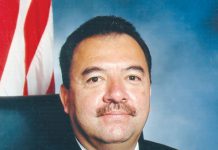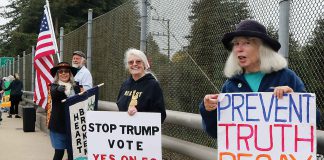By TRINA COFFMAN-GOMEZ
This article is part two of a series about our county’s transportation discussion.
While there are many more reports and milestones the Regional Transportation Commission (RTC) has accomplished, here is my summary of the history lesson.
In 2000, it was determined that the RTC would serve as a Rail/Trail Authority for Santa Cruz County. In 2012, the branch line right of way was purchased and paid in part by funds from Proposition 116, called the Clean Air and Transportation Improvement Act of 1990, a $1.99 billion bond that was for passenger and commuter rail.
In 2013, the Monterey Bay Sanctuary Scenic Trail (MBSST) Master Plan was completed. This document provides the blueprint for a network of trails, including a 32-mile Coastal Rail Trail for bicyclists and pedestrians along the existing railroad right of way. This network of trails will provide community and coastal connectivity and serve as a transportation, recreation, health, eco-tourism, coastal access and economic activity “spine” for our entire region that would co-exist with freight and passenger service.
In 2015, the RTC completed a rail feasibility study with planning grant funds secured from Caltrans. One of the primary conclusions of this report indicated that rail was essential for a stronger local economy and quality of life, improvements in the housing supply and the transportation network that can provide: ease of traffic congestion, compact land use, reduce emissions, improve connectivity, and has the capacity to scale to the needs of the community. The RTC did not select one rail service scenario but specifically excluded the scenarios that would not serve Watsonville in their final action.
In November 2015, a draft environmental impact report from Caltrans was issued for the county’s highway projects to assist the RTC with planning Highway 1 improvements once the report is finalized.
In 2016 the voters approved Measure D. Funds from this measure were distributed at 30 percent toward neighborhood projects, 25 percent toward highway corridors such as Highway 1, 17 percent for active transportation for the Monterey Bay Sanctuary Scenic Trail Network and 8 percent for the rail corridor for the railroad infrastructure preservation and options analysis.
Just this year, the 2018 Caltrans State Rail Plan was completed and its 2040 vision “supports establishment of a regional rail network on the Central Coast, providing connection from Santa Cruz, Monterey and Salinas to the state network in Gilroy; with the possibility of different train outings to allow Santa Cruz to Monterey service, providing for increased transportation capacity in the constrained coastal Highway 1 corridor.”
Today, we now have the results of an arduous study called the Unified Corridor Investment Study (UCS). It is now in a draft version of a working, planning transportation investment document that studies three parallel routes that connect us from Watsonville to Davenport.
The UCS report synthesizes all the previous reports where it studies and analyzes 16 performance measures that compare and contrast various projects, and the options and impacts these decisions would have in our county. These performance measures look at safety, efficiency, economics, environmental sustainability and social equity.
The study evaluates findings and data from various third-party engineering and consultant sources that have intensely studied the corridor throughout the years. The RTC is currently presenting the UCS to the public through workshops and meetings with stakeholders, community groups, city councils, etc. to collect as much feedback as possible from as many Santa Cruz County residents as possible. Additionally, UCS resources and content are available in Spanish on their website.
Whether you drive, bike or walk in Santa Cruz County, this decision will have an impact on how you plan on getting around the county. This is your opportunity to voice your opinion and ask questions to help shape the future of our transportation needs. The RTC will continue to expand on its most frequently asked questions, which are posted on the RTC website, and will continue to do as much public outreach as possible to gather productive public feedback.
What is excluded from this report are options that have previously been eliminated because they simply are not feasible for us to consider, primarily due to lack of funding or due to land use restrictions. The RTC is in a holding pattern to move forward with many projects until this is finalized, which means they cannot take action to seek funding, which is why it is important now, during this public comment period, that we hear from the public for their input on our transportation future.
•••
Trina Coffman-Gomez is a councilwoman for the City of Watsonville and is also the city’s representative on the Regional Transportation Commission. She is writing a series of articles this month to break down the information on the decisions and projects the RTC will identify to improve moving people in Santa Cruz County.












